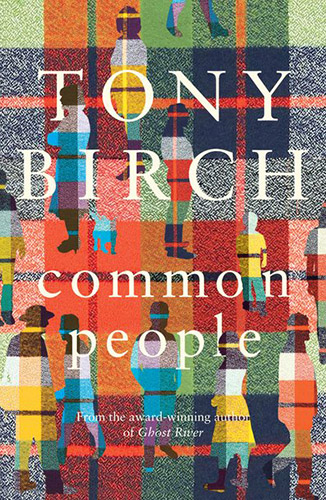Robert Wood is a recipient of a 2017 SRB-CA Emerging Critics Fellowship. This is the second of three essays by Wood that will appear on the Sydney Review of Books, alongside essays by other fellowship recipients, Rita Horanyi and Darius Sepehri. Read all the essays here.
I had read criticism of Tony Birch’s short story collection Common People before I read the book itself. I had heard the author speak on national radio, stumbled across reviews and read literary journal articles. What I quickly gleaned from the commentary was that Birch has ‘compassion’ and his common people are ‘resilient’. I read the book and I could not disagree. Some of the stories in Common People are based on Birch’s own personal experiences, but all of them display a striking intimacy with the lingua franca of grit, scrabble, labour. They are stories about mundane and quotidian lives on the margins of Australian society. Other critics asked: what keeps his characters going in the face of hardship? Sometimes it is alcohol, sometimes it is humour, sometimes it is small acts of kindness. All of these things allow Birch’s downtrodden to find ways to live another day. Often the hardship his characters face is structural and the forces they struggle against are greater than themselves. Power is out there. Yet it manifests in particular ways, and oppressing individuals in ways that are specific to their lives.
For example, in ‘The Ghost Train’, two women, Marian and Lydia, take a night’s work at an illegal abattoir on the outskirts of town. The opening scenes narrate their drive to work. It is humorous and a little bawdy, but the tone of the piece turns dark when Lydia takes a toilet break once they have arrived at work. Searching for the loo, she comes across a worker who is turning greyhounds to mince. As Birch writes:
The worker who’d been picked up last on the line was dragging a carcass from a truck. His overalls were covered in blood and mud and shit. The animal had been skinned and the ears had been cut off. The back of the truck was loaded with more carcasses…. The worker picked up the carcass, straining under its weight, and dropped it into the barrel of a machine. He hit a button on the side of the machine and stood back. The crunching of bones and flesh soon reduced the carcass to mince. Unable to stop herself, Lydia fell to her knees and vomited over the edge of the platform.
The manager, fat and seedy, who had eyed Lydia as soon as she arrived, comes along and escorts her back inside. He asks:
‘You enjoying the work?’
‘Yeah. It’s fine.’
The manager rested a hand on her waist. ‘There’s guaranteed work here if you want it.’
The manager is an opportunist flexing his industrial relations power, hoping to leverage it into a sexual exchange. Compare this to the opening of the story, to the candid and humorous conversation between the two women about intimacy. Men pose a threat – to women in the workplace, and to animals. Marian and Lydia battle on, packing meat into trays and boxes until they are paid their $150. The redeeming moment in the story comes towards its close when a female co-worker, Rose, hands them each packets of meat she has stolen from the bosses. It is a touching moment of camaraderie that restores the good feeling the story opened with – work and men cannot break the solidarity of women.
What this and other stories suggest is Birch’s attention to the symptoms of neoliberalism and his care for characters as individuals. ‘The system’ is not a problem in the abstract; it materialises in ways that have particular consequences for individual people. For example, in ‘Sissy’ we have a response to the removal of children. The story focuses on Sissy who is gifted a ‘holiday’ with a wealthy white family by Sister Mary, a nun at her Christian school. Her best friend, Betty enlightens her as to why she was chosen for this honour, saying:
‘It’s because you have whiter skin than me. And your hair is nicer. Mine’s like steel wool and yours is like straw. You’re exactly what them rich white people want, Sissy.’
Sissy protests, but Betty keeps pushing, sowing the seeds of doubt as to whether this ‘holiday’ is something anyone should actually want. She says:
‘One of my cousins, Valda, the Welfare told her mum, my auntie, the same story, that she was going on a holiday. Valda was excited, just like you are now. You know what happened to Valda? She disappeared.’
Sissy does get in the car, but Betty springs her loose as they start to drive away. The two friends escape and run away leaving behind Sissy’s belongings. Sissy turns to Betty and says:
‘I’m home with you.’
‘I knew you wouldn’t go off with a strange lady.’
It is a tender and affecting portrayal in a story that many Australians might think they know. In it, we recognise a bond that reminds us of Marian and Lydia’s connection, and shows us how systemic power affects children in particular. What emerges from the paradigm of the Stolen Generations is a subtle portrait of resilience and friendship.
This sensitivity to structural forces and larger narratives is apparent too in ‘Painted Glass’, which focuses on Tom, a recently sacked journalist, and his psychologist. As Birch writes:
That first session [of counselling] had begun with Tom explaining the circumstances that led to his breakdown. He was not the only journalist who’d been let go by the newspaper. Sixty staff members had received redundancy notices on the same day, some of them senior editors. In the compulsory exit interview he’d been reassured that the circumstances of his dismissal were a macro issue and that he shouldn’t feel personally inadequate.
The italics make explicit that Birch’s characters are subject to the market, restructuring, unemployment and the specific language it trades in. In Tom’s case, we hear of his loneliness, anger and shame. His feelings of inadequacy come through in the dialogue with his psychologist, in short scenes outside the counselling sessions, and through small authorial interjections. The story ends, like ‘The Ghost Train’ and ‘Sissy’ before it, with a sense of resolution thanks to a small act of kindness. As Tom looks at a piece of art in a gallery, the attendant speaks to him:
‘Are you an artist?’
‘No.’ She shook her head. ‘I’m here to guide people. It’s enough for me. Are you an artist?’
‘No. I came here to look around. I… I’m a writer.’
‘A writer. Wow!’ She again looked up. ‘I’m sure there’s plenty in here for you to write about.;
Tom also looked at the colourful ceiling. ‘Yes. I think there might be.’
Tom begins to think about returning to his craft after this conversation. The final line of the story reads: ‘He stopped, looked down and contemplated the task of putting words together.’ The ties that bind, the social relations that matter, offer these moments of unexpected coalition. Through such encounters even common people can create little breaks and moments of luck that allow them to keep going when the chips are down.
Read as a whole, Common People proposes a materialist understanding of Geist and how it is expressed in specific languages and gestures. The collection does not propose that class trumps race or that race trumps class or that any single way of looking at people can be divorced from any other. No valence of identity explains all, precisely because the characters are deftly drawn. There is Lydia, Sissy, Tom. They, like others, are not cardboard cut-outs shifted from stage left to stage right. They are not stereotypes brought in to make a political point. We must respond to the lived difficulties of these common people through the politics of solidarity.
In this way Common People does make available a defence of the bad, white working class. But more imporantly it is about reaching out from the particularity of one’s own condition, experience, identity, of making a single person part of a union and world that is complex. It is about articulating what a coalition of characters might become when we consider our collective interest as a whole. That might mean becoming conscious of fair wages and just industrial relations in Marian and Lydia’s case, of using jokes to protect each other from blows as Betty and Sissy do, of finding succour in art and one’s own craft as Tom does.
In so doing, Common People contributes to rich and diverse thread of activist Australian literary history, one dominated by social realists. This is a tradition that refers back to, among other notable works, the short fiction of John Morrison and to Donald Stuart’s Yandy (1959), a novel about the 1946 Pilbara Strike, which was the first mass industrial relations strike by pastoral workers and laid the foundation for modern land rights activism. It encompasses the polyphonic cross section of society represented in works such as Xavier Herbert’s Capricornia (1938), Frank Hardy’s Power Without Glory (1950) and DH Lawrence’s Kangaroo (1923). Birch’s inflection of this tradition responds to our contemporary moment, incorporating into its frame a response to liberalism’s identity politics. Building on solidarity, we understand our moment now, where the stranglehold of late capitalism manifests through consumer fetishes, digital revolutions, and the surveillance state. In that way, his work is a history of the present that builds out of an understanding of present collectives of people affected by late capitalism. And yet Common People finds in community a sense of possibility.
This literary commitment to community and to common people points us to the light on the hill. Birch has fellow travellers in other contemporary writers, such as those associated with Overland, Collective Effort Press and Susan Hawthorne’s stable at Spinifex, but he is unique in mapping a path that Others can walk upon towards a better world. With Birch, this does not mean a nostalgic, reactionary and naïve return to a class of macho larrikins, blokes you know from the hard drinking trade unions in Hawkey’s era. But it is responsive to the social relations of the marginalised and so offers a contemporary hope about what might be accomplished when we simply work with each other. Birch’s representation of Indigenous women, people on welfare, pregnant teens, is neither ventriloquism nor appropriation; it’s an effort to build a coalition grouped around solidarity. And so, Common People voices resistance and utopia, is part of a chorus that knows the Internationale and ‘Treaty’. Birch contributes new lyrics that sing truth to power even if our mates have been silenced so far. This, finally, is what Birch’s book enables – beyond the observation that he is compassionate to those less fortunate than literary critics themselves. Common People is a solemn reminder that in a world as cruel as ours we might live better when we have a bit of labour to hold us together.






